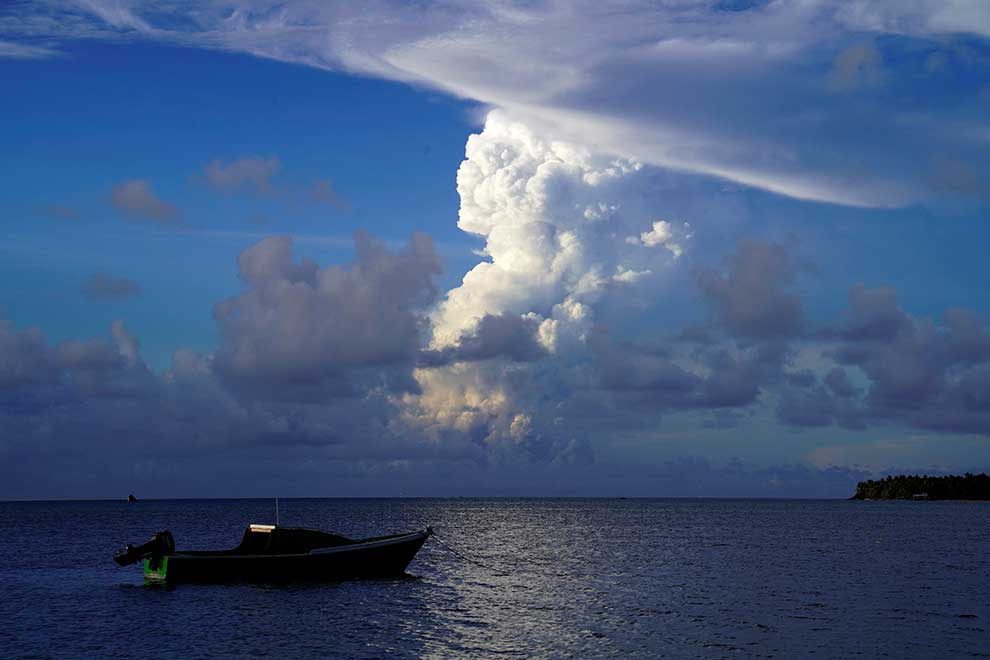
White gaseous clouds rising from the Hunga Ha’apai eruption seen from the Patangata coastline near Tongan capital Nuku’alofa on December 21. AFP
A massive volcanic eruption in Tonga that triggered tsunami waves around the Pacific caused “significant damage” to the island nation’s capital and smothered it in dust, but the full extent was unclear with communications still hampered on January 17.
The eruption on January 15 was so powerful it was recorded around the world and heard as far away as Alaska, triggering a tsunami that flooded Pacific coastlines from Japan to the US.
The capital Nuku’alofa suffered “significant” damage, New Zealand Prime Minister Jacinda Ardern said, adding there had been no reports of injury or death but a full assessment was not yet possible with communication lines down.
“The tsunami has had a significant impact on the foreshore on the northern side of Nuku’alofa with boats and large boulders washed ashore,” Ardern said after contact with the New Zealand embassy in Tonga.
“Nuku’alofa is covered in a thick film of volcanic dust but otherwise conditions are calm and stable.”
Tonga was in need of water supplies, she said, as “the ash cloud has caused contamination”.
There has been no word on damage in the outer islands but New Zealand sent an air force reconnaissance aircraft early on January 17 “to assist in an initial impact assessment of the area and low-lying islands,” the country’s Defence Force said.
Tonga has also accepted Canberra’s offer to send a surveillance flight, Australia’s foreign office said, adding it is also immediately prepared to supply “critical humanitarian supplies”.
The US and the World Health Organisation have pledged support, while the UN children’s agency said it was preparing emergency supplies to fly in.
A 1.2m wave swept ashore in the Tongan capital with residents reporting they had fled to higher ground, leaving behind flooded houses, some with structural damage, as small stones and ash fell from the sky.
Dramatic satellite images showed the long, rumbling eruption of the Hunga Tonga-Hunga Ha’apai volcano spew smoke and ash in the air, with a thunderous roar heard 10,000km away in Alaska.
The eruption triggered tsunamis across the Pacific with waves of 1.74m measured in Chanaral, Chile, more than 10,000km away, and smaller waves seen along the Pacific coast from Alaska to Mexico.
In California, the city of Santa Cruz was hit by flooding due to a tidal surge generated by the tsunami, while waves of around 1.2m hit along Japan’s Pacific coast.
The US Geological Survey recorded January 15’s eruption as equivalent to a 5.8-magnitude earthquake at zero depth.
The volcano’s eruption lasted at least eight minutes and sent plumes of gas, ash and smoke several kilometres into the air.
The eruption was so powerful it was even heard in Alaska, the UAF Geophysical Institute tweeted, saying the fact it was audible was “fairly unique.”
It cited Alaska Volcano Observatory scientists David Fee as recalling “only a couple other volcanic eruptions doing something like this” – namely, the 19th-century eruption of Indonesia’s Krakatau, and Alaska’s Novarupta, the most powerful volcanic eruption of the 20th century.
The Fife weather station in Scotland tweeted it was “just incredible to think of the power that can send a shockwave around the world” after the eruptions produced a jump in its air pressure graph.











